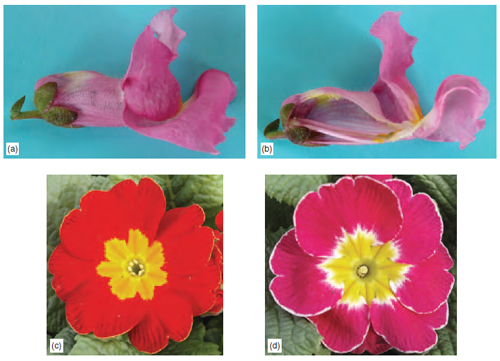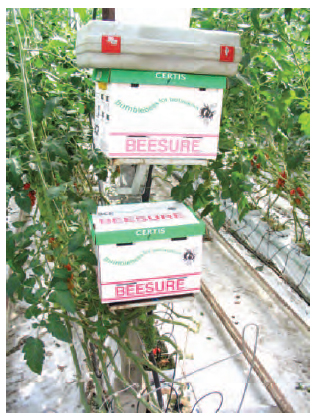Pollination
ContentThe flower’s function is to bring about sexual reproduction (the production of offspring following the fusion of male and female nuclei). The male and female nuclei are contained within the pollen grain and ovule respectively and pollination is the transfer process. Crosspollination ensures that variation is introduced into new generations of offspring. Self pollination occurs when pollen comes from the same flower (or a different flower on the same plant) as the ovule, common in Fabaceae (bean family). Cross-pollination occurs when pollen comes from a flower of a different plant, with a different genetic make-up from the ovule, common in Brassicaceae (cabbage family). Natural agents of cross-pollination are mainly wind and insects.
The characteristics of wind-pollinated flowers are their small size, their green appearance (lacking coloured petals), their absence of nectaries and scent production, and their production of large amounts of pollen which is intercepted by large stigmas. They also often have proportionally large stigmas that protrude from the flower to maximize the chances of intercepting pollen grains in the air. The commonest examples of wind-pollinated plants are the grasses, and trees with catkins such as Salix (willow), Betula (birch), Corylus (hazel), Fagus (beech), Quercus (oak). The Gymnosperma (conifers) also have wind-pollination from the small male cones.
Certain Primula spp. have stigma and stamens of differing lengths to encourage cross-pollination; in thrum-eyed flowers, the anthers emerge further from the flower than the stigma, so that insects rub against them when reaching into the flower tube; in pin-eyed flowers, the stigma protrudes from the flower and will catch the pollen from the same place on the insect body, so ensuring cross-pollination (see Figure 10.4). Bees in pollination The well-known social insect, the honey bee (Apis mellifera), is helpful to horticulturists. The female worker collects pollen and nectar in special pockets (honey baskets) on its hind legs. This is a supply of food for the hive and, in collecting it, the bee transfers pollen from plant to plant. Several crops, such as apple and pear, do not set fruit when self-pollinated. The bee therefore provides a useful function to the fruit grower. In large areas of fruit production the number of resident hives may be insufficient to provide effective pollination, and in cool, damp or windy springs, the flying periods of the bees are reduced.
It may therefore be advantageous for the grower to introduce beehives into the orchards during blossom time, as an insurance against bad weather. One hive is normally adequate to serve 0.25 ha of fruit. Blocks of four hives placed in the centre of a 1 ha area require foraging bees to travel a maximum distance of 70 m. In addition to honey bees, wild species, e.g. the potter flower bee (Anthophora retusa) and red-tailed bumble-bee (Bombus lapidarius), increase fruit set, but their numbers are not high enough to dispense with the honey bee hives. All species of bee are killed by broad spectrum insecticides, e.g. deltamethrin, and it is important that spraying of such chemicals be restricted to early morning or evening during the blossom time period when hives have been introduced. In commercial greenhouses, the pollination of crops such as tomatoes and peppers is commonly achieved by in-house nest-boxes of bumble-bees, Bombus terrestris (see Figure 10.5). Plant breeders may use blowflies in glasshouses to carry out pollination. They also perform mechanical transfer of pollen by means of small brushes. When a pollen grain arrives at the stigma of the same plant species, it absorbs sugar and moisture from the stigma’s surface and then germinates to produce a pollen tube . The pollen tube contains the ‘ male ’ nucleus (and also an extra ‘second nucleus’). These nuclei are carried in the pollen tube as they grow down inside the style and into the ovary wall. Fertilization After entering the ovule, the male nucleus fuses with the female nucleus, their chromosomes becoming intimately associated. The term ‘gamete’ is used to describe the agents, both male and female, that are involved in fertilization. In animals, the gametes are the eggs and sperms. In plants, they are the ovules and pollen. Incompatible, in relation to fertilization, is a genetic mechanism that prevents self fertilization, thus encouraging crosspollination, e.g. in Brassicaceae. The mechanism operates by inhibiting any of the following four processes:
Parthenocarpy, where fertilization does not occur before fruit formation, is a useful phenomenon when the object of the crop is the production of seedless fruit, as in cucumber. It is usually accompanied by a high level of auxin in the plant and may be induced in pears by a spray of gibberellic acid. The fertilized ovule (zygote) undergoes repeated cell division of its young unspecialized cells before beginning to develop tissues through differentiation, that form the embryo within the seed. Additionally, however, it should be noted that there is often a second fertilization within the ovule, which has led to the term ‘double fertilization’ . The second fertilization involves the ‘second nucleus’ of the pollen tube (mentioned above) fusing with two extra (‘polar’) nuclei present in the ovule itself. The resulting tissue consequently contains three sets of chromosomes (triploid) and is called endosperm. Endosperm is a short-term food supply used by the embryo to help its growth. Endosperm is found in the seeds of many plant families, but is best developed in the grass family. In maize seed, for example, the endosperm often represents more than half the seed volume. Anyone making popcorn will be eating ‘exploded endosperm’ . Not all parts of a seed are derived from embryo or endosperm origins. The outer coat (testa) is formed from the outer layers of the ovule and is thus maternal in origin. Also, the ovary, which contained the ovules in the flower before fertilization, develops and expands to form the fruit of the plant (see seed structure). In the previous sections of this chapter, descriptions have been given of the plant processes that lead to the development of a seed. Genetics also requires some knowledge of the microscopic details of reproductive cells and of the biological processes in which they are involved, since this knowledge explains how plant characteristics are passed on from generation to generation. |








